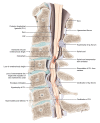Degenerative Cervical Myelopathy: A Clinical Review
- PMID: 29599656
- PMCID: PMC5872640
Degenerative Cervical Myelopathy: A Clinical Review
Abstract
Degenerative Cervical Myelopathy (DCM) is the most common form of spinal cord impairment in adults and results in disability and reduced quality of life. DCM can present with a wide set of clinical and imaging findings, including: 1) pain and reduced range of motion of the neck, and motor and sensory deficits on clinical exam, and 2) cord compression due to static and dynamic injury mechanisms resulting from degenerative changes of the bone, ligaments, and intervertebral discs on MRI. The incidence and prevalence of DCM has been estimated at a minimum of 4.1 and 60.5 per 100,000, respectively, but surgical trends and an aging population suggest these numbers will rise in the future. The diagnosis of DCM is based on clinical examination, with a positive Hoffmann's sign and hand numbness typically appearing in the upper limbs, and gait abnormalities such as difficulty with tandem gait serving as sensitive diagnostic findings. Loss of bladder function may also occur in patients with severe DCM. The degree of neurological impairment can be measured using the modified Japanese Association Scale (mJOA) or Nurick grade. Non-operative management has a limited role in the treatment, while surgical management has been shown to both be safe and effective for halting disease progression and improving neurological function. Predictors of surgical outcome include age and baseline severity, indicating that early recognition of DCM is important for ensuring an optimal surgical outcome.
Keywords: Cervical Spondylotic Myelopathy; compressive myelopathy; pain; sensation.
Figures



References
-
- Kalsi-Ryan S, Karadimas SK, Fehlings MG. Cervical spondylotic myelopathy: the clinical phenomenon and the current pathobiology of an increasingly prevalent and devastating disorder. Neuroscientist. 2013;19(4):409–21. - PubMed
-
- Nouri A, Tetreault L, Singh A, Karadimas SK, Fehlings MG. Degenerative Cervical Myelopathy: Epidemiology, Genetics, and Pathogenesis. Spine (Phila Pa 1976). 2015;40(12):E675–93. - PubMed
-
- Wu JC, Ko CC, Yen YS, Huang WC, Chen YC, Liu L, et al. Epidemiology of cervical spondylotic myelopathy and its risk of causing spinal cord injury: a national cohort study. Neurosurg Focus. 2013;35(1):E10. - PubMed
-
- New PW, Cripps RA, Bonne Lee B. Global maps of non-traumatic spinal cord injury epidemiology: towards a living data repository. Spinal Cord. 2014;52(2):97–109. - PubMed
Publication types
MeSH terms
LinkOut - more resources
Full Text Sources
Medical
